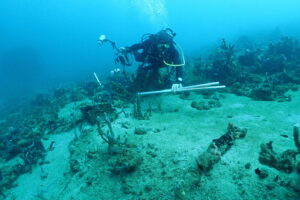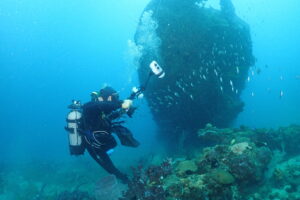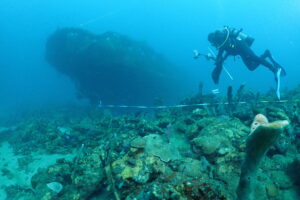by Chuck Meide
I was just 26, a bright-eyed graduate student at Florida State University, and it was the archaeological project of a lifetime. My friend and colleague David Johnson was a grad student at Texas A&M University. He’d taken a phone call from St. Vincent and the Grenadines, an island nation in the extreme southeast of the Caribbean. Better known now, but not then, as the scenic island filmed on location for Disney’s Pirates of the Caribbean. The government of St. Vincent was calling because they thought they had the wreck of the slave ship Africa, lost in 1784 in Kingstown Harbour, the bay fronting their capital city and principal port.
They flew David down to dive on the wreck, situated on a sloped bottom between 70 and 110 feet deep, and he came back wide-eyed with stories of coral-encrusted cannons and anchors and cooking cauldrons. He thought the wreck was too big and well-armed to be a slave ship and felt it was more likely to be a British warship. It was undoubtedly a plausible identification, as the island of St. Vincent had been hotly contested between the British and French and frequently switched back and forth between the two great colonial powers. Both battled in various armed conflicts until after the American Revolution when Britain would finally reign supreme there.
David and I agreed to serve as co-Directors for the project. The expedition was officially sponsored by the Institute of Maritime History (IMH) and Florida State University, with just enough funding from the Organization of American States and the government of St. Vincent and the Grenadines to make an expedition happen if all of the archaeologists worked for free. A 16-person crew was assembled, consisting almost entirely of archaeology graduate students.
FSU sent a shipping container full of diving gear, compressors, and giant oxygen tanks months ahead of time from Tallahassee. For thirty days in December 1997 and January 1998, our IMH/FSU team dived continuously to generate a highly accurate map of the shipwreck and its artifacts and to raise one cannon for cleaning and conservation in hopes of identifying the wreck.
It was a beautiful diving site. The historic wreck was in crystal clear water and covered in colorful marine life, overshadowed by the looming blue shadow of the massive steel wreck Seimstrand, which had foundered in a 1984 hurricane and coincidentally landed almost on top of the 1700s wreck.
It was also a groundbreaking endeavor, the first archaeological project in a remote locale to custom-mix nitrox breathing gas to safely work at those great depths. We pulled off every objective without a single safety incident, which was a great success. The big surprise came when we cleaned the cannon raised from 110 feet deep, which bore the year 1776. We had expected to find the iconic “broad arrow” denoting British government property, like that on the Industry cannon in the Museum visitor center. Instead, we found three fleur-de-lys, the national symbol of France. It was a French military cannon, cast in the royal foundry of Ruelle, and therefore a French warship, not a British one.
At the time, our research convinced us we had a French frigate, one outfitted and lost sometime between 1776 and 1785, that had likely sunk at anchor during a hurricane after striking the nearby cliffs, just like the steel ship Seimstrand had in 1984. Our colleague, John de Bry of the Center for Historical Archaeology, was a French historian and archaeologist. He met a dead end in the French archives when papers that might have revealed which ship loaded our cannon turned out to be among hundreds of records accidentally burned by allied bombing in WWII. We, therefore, never were able to identify our ship by name.
We published a technical article on the wreck in the journal Underwater Archaeology. We produced a report, and then time went on, as it does. This project faded fondly into my memory as one of the most exciting and meaningful experiences I’d ever had as a young archaeologist. My career marched on with Ph.D. studies at the College of William & Mary. Then I got the position as Director of the Lighthouse Archaeological Maritime Program, LAMP, here at the St. Augustine Lighthouse & Maritime Museum. I’ve been busy with my new team members ever since, immersing ourselves in the maritime history of our nation’s oldest port.
Fast-forward 21 years, and I was at the Society for Historical Archaeology’s 2020 Conference on Historical and Underwater Archaeology, an annual pilgrimage for us every January. My colleague Jean-Sebastien Guibert, a Frenchman and the Chair of the History Department at the University of the French Antilles in Martinique, had read my old article on the Kingstown Harbour Wreck and wanted to talk. We met in the lobby of a Boston hotel with our laptops. I showed him the old photos from the project, beautiful shots of the wreck and its artifacts despite their pitifully low resolution compared to photographs taken with digital cameras today. Then he pulled out his laptop and began to translate for me a document he’d found in the French archives.
It was the account of the loss of the French frigate Junon, a 32-gun 540-ton frigate built in Rochefort, France, in 1777. The vessel had a storied but brief career during the American Revolution, taking part in the Battle of Ushant and capturing a total of three British warships before its untimely demise. On its final, fateful voyage, the Junon arrived in St. Vincent from Martinique with hospital supplies. At anchor in Kingstown Harbour on 11 October 1780, when the hurricane struck, the captain and crew had no warning as the ship’s barometer had broken on a recent voyage. The shrieking winds and churning seas threw the beleaguered vessel against the cliffs twice, and her men were toiling relentlessly at the pumps before the captain realized there was no hope to save the ship. Cannons were jettisoned to delay its sinking, with others moved from one side of the vessel to the other. This method was used to lean the ship’s masts against the cliffs to allow the crew a means of escape. Once the entire crew climbed to safety, the captain turned to see his beautiful frigate Junon slip beneath the waves forever.
My jaw had dropped, my heart raced, and my world spun. After more than two decades, we had finally identified our shipwreck! It was the Junon; it could only be the Junon! What’s more, Jean-Sebastien invited me then and there to join his crew for a planned expedition to the wreck site to reinvestigate it. Back in St. Augustine, Executive Director Kathy Fleming agreed to let me participate in this project as a representative of LAMP and the Museum, for which I was extremely grateful. I couldn’t believe how my life had come full circle and was bringing me back to my beloved shipwreck in beautiful St. Vincent.
It was a dive 23 years in the making. Jean-Sebastien and I launched ourselves into the azure waters beneath jungle-green cliffs and descended silently to the bottom. It was exciting and surreal, with no throbbing gush of bubbles to mar our thoughts and anticipations. We saw the towering bulk of the Seimstrand wreck, headed towards it, and then came across the remains of copper sheathing, complete with tiny copper nails, protruding from the sand. It was a tell-tale sign of Junon, whose bottom was covered in copper sheets to prevent damage from shipworms and other wood-eating organisms. For a while, I was confused about the wreck’s layout, as it seemed everything had changed until I finally realized that Junon was in the same place, but the steel wreck Seimstrand had moved some 20 meters downslope!
Locals later told us the company that built the cruise boat dock dragged it to deeper water to prevent it from being a hazard to navigation for the deep-drafted cruise boats. But once I realized this primary reference point had shifted, everything else on the wreck fell into place, matching both my memory and the site plan we’d brought with us underwater. I recognized concreted and coral-encrusted cannons, arranged just as they had been decades ago, along with distinctive patches of copper sheathing marking the stern end and midships starboard side of the vessel, square and round copper cauldrons, an enormous 16-foot long anchor, and a lead hawsepipe at the bow of the wreck. I couldn’t relocate some objects, probably because they had become overgrown with marine life or buried in the sand off the reef. But this was our wreck, almost precisely as we’d left it so many years before.
Our remaining days were spent prepping for and executing a series of hundreds of photographs of the wreckage to generate a 3D digital photo model of the site. The computer will take some time to make the innumerable calculations necessary to stitch together all of the photographs and make a seamless image that can be rotated for better views and used to record scaled measurements, but we believe we accomplished this goal. Photogrammetry is the fastest way to generate a scaled representation of a wreck. For reference, this accurate map only takes a matter of several days to complete. In comparison, it took 30 days to create using the latest computerized technology available to us back in the 1990s. The modern photo model will be a valuable tool to compare with the previous map to better understand how the wreck has changed over two decades. A rare opportunity in maritime archaeology that will help Jean-Sebastien as he plans future field seasons for this wreck. These future seasons will include excavation to uncover the ship’s timbers and more artifacts.
As for me, it feels as if I have returned from a great adventure. The wreck of Junon reminds me of how capricious nature, history, and life can be. The storm that ended Junon’s life was memorialized as the Great Hurricane of 1780, wrecking multitudes of French and British warships across the West Indies, and undoubtedly changed the course of history. Junon was sent to the Caribbean to sustain the French effort to aid the upstart Americans in their Revolution against the British. If not for the storm, Junon might have supported Washington at Yorktown or harassed the fleet that evacuated Charleston and carried thousands of refugees to St. Augustine in 1782. That same fleet resulted in the loss of the unidentified Storm Wreck, whose artifacts are now on display at our Museum in the Keepers’ House. This wreck has taken me full circle from a young archaeology student to a seasoned scholar whose career has matured. I can’t help but think of my own life’s journey and what fate has in store for me as I look forward to the many more archaeological adventures that lie ahead.



Photos Above: Chuck Meide on Junon with steel wreck Selmstrand (photo by Claude Michaud)

